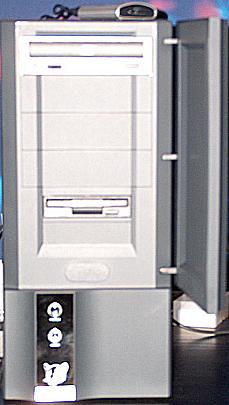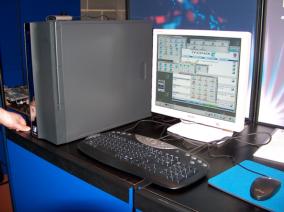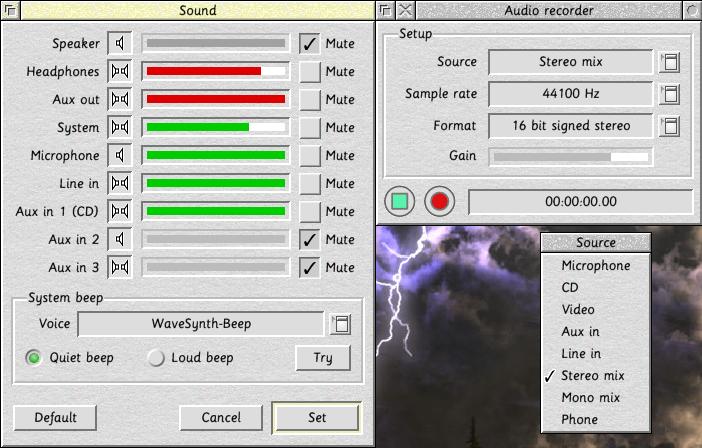



Iyonix Issues
Mark Rowan with our Iyonix column.
Wakefield fun
New machines
In May I had the wonderful pleasure of visiting the Wakefield show for the first time. There were plenty of exciting things to see, but no doubt you've already read the RISCWorld report from last issue so I won't bore you with the details.
However of specific interest to IYONIX users were Castle's announcements of yet another new range of machines. Or - to be more accurate - new case designs. True, the X100 desktop case was hardly ground breakingly exciting, but as I reported in March the new case was a result of Castle listening to big corporate customers, and significantly it allows compliance with the US radiation standards.
Castle's new Panther PC features a very nice sleek black case (wonder where the inspiration for the name came from?) with an attractive mirror strip down the front, and this time unlike the X100 case it's BIG. It has space for eleven drives compared the standard IYONIX case which can hold just five. Before you stop me, yes, I know... there is only space on the motherboard for four IDE drives to be connected. Thing is, Castle know this too, and when I quizzed John Ballance (Castle's technical director) on what they plan to do about it, he told me that when SCSI is supported it will enable access to drives housed in the other seven of those bays.

Castle's sleek new Panther case. Notice the mirror strip
all the way down the front of the case, and the red LEDs at the top.
Yes, you heard me right, John Ballance stated that SCSI support for the IYONIX is a case of "when" not "if". What he wouldn't be drawn on, however, is "how soon?"
It seems that the Panther case has been designed to satisfy those who were complaining about the lack of expandability of the standard IYONIX, or those complaining that the standard case isn't terribly attractive. It features a solid-feeling drive bay door which swings open from the left-hand side in much the same sort of function as the RiscPC door, although that one was sprung whereas the Panther could quite easily flap about in the wind if you're not careful. Rather cunningly the drive bay door is held shut by magnetic attraction. It's easy to flip open but not so easy that it will open of its own accord and cause problems.

Panther case with open drive bay door, revealing six of the
eleven drive bays (four are hard disc drives not accessible from the front).
The other most noticeable thing about the Panther is the three-figure red LCD panel at the top of the case. This gives a temperature readout from a sensor which apparently the user can choose where to put inside the case (or outside if you fancy making a thermometer out of your IYONIX). Throughout my time at the show this figure stayed at approximately 29 degrees C, which isn't bad considering the room temperature was around 21 degrees or higher.
The Panther is otherwise identical to the standard tower IYONIX. It uses the same silent power supply coupled with convection cooling, meaning the Panther is no more noisy than the standard tower version. The case, which doesn't support Acorn podules by the way, can be opened easily using 'thumb screws'. Rather than being an instrument of torture, what it means is that you just press and twist on a couple of screws and, again much like the RiscPC, the case can then be opened without the use of tools.

Complete Panther system with supplied matching keyboard and mouse, as well as one of
the LCD monitors which are currently on offer with every purchase (click for bigger image).
TC edition
A month after the Wakefield show Castle announced a new addition to the Panther range: an almighty beefed-up machine with two 120GB silent fast (7200 rpm) hard drives and 1GB of RAM. Surely this is the most extravagant RISC OS machine ever produced - it's certainly the first one to my knowledge sporting a gigabyte of RAM, something until now reserved for PC games players or Mac graphics enthusiasts.USB2 and ADFS updates
In an unusual move for Castle, drivers for USB2 were being demonstrated at the show in a pre-release stage. I didn't have much chance to play with them but they already support the huge increase in transfer speed which USB2 provides to compatible devices. John Ballance told me that they weren't at the time sure whether the drivers would be released free of charge or not. If they were to be chargeable updates, it's quite likely that Castle would adopt an Aemulor-style lock to your machine's MAC address.
Neil Spellings was talking enthusiastically about the recently-announced initiative to work with Castle in implementing non-blocking disc transfers in ADFS. This is necessary for the upcoming Cino (pronounced "Chee-no" by the way) DVD player software, as currently RISC OS reads from CDs and DVDs by sending the read request, then waiting around doing nothing until the data is received. Because Cino will be pushing the XScale processor so hard to decode the data in time, it's not really wise to have the system waiting idle for the DVD drive to respond, so a new method of data access where the XScale can process information at the same time as getting data from drives will be implemented.
RISC OS already gives the impression of simultaneous data reading and processing by pausing briefly between read operations, allowing RISC OS to do something else in this time. This is what happens when you use the filer to copy a file from a CD to the hard disc, for example. When you click on 'faster' the system reduces the number of these polls between read operations, which is why your desktop grinds to a halt.
However it's important to note that implementing non-blocking transfers doesn't mean that using the filer to copy files off your CD drive will become smoother or faster. The sort of changes being implemented to ADFS are for low-level direct disc access (as used by CinoDVD) only.
A bit of Castle Wizardry
Castle announce Merlin update scheme
Since the last issue of RISCWorld project Merlin's consultation phase has come and gone. Merlin is the name given to the long-term enhancement process for desktop RISC OS (that means your IYONIX). A mailing list was set up and for six weeks the entire RISC OS community was invited to suggest enhancements they want to see made to RISC OS 5.
The initial take-up was immensely encouraging. Many hundreds of posts were made within the first couple of weeks, discussing proposed features and adding new ones to the database. Even by the end of the six-week period new features were being added to the wishlist almost daily. I suppose this reflects on the disappointing lack of user-visible desktop development done to RISC OS since its early days back at Acorn. The under-the-bonnet work to date has certainly been superb though - otherwise we wouldn't even be using RISC OS on an XScale processor with 'foreign' PC graphics cards!
Many of the features suggested have already been implemented in RISC OS Select and I imagine many people - irritated at the apparent lack of movement from RISC OS Ltd in the direction of providing Select desktop enhancements for the IYONIX - decided to make good use of this open consultation process and make their voices heard.
Also the fact that Merlin has been promised largely free of charge may have tempted many (ex-)Select subscribers to add to the list. Compared to the £150/year subscription for Select I think anything free of charge from Merlin will be eagerly received. Castle intend to issue releases in the form of 'Desktop Packs' although they "reserve the right to implement a charging structure for some features".
Testing, testing...
Already the first Merlin item has been released to IYONIX users. AudioIn implements a new sound-capture interface for the machine, allowing users to simply and quickly record audio from the input ports on the back of the computer and internally as well (eg. from a CD drive).
I've tested the Microphone and Line In inputs with variable success. Microphone input is currently very quiet but this is being looked into as we speak. Line In is far more usable, allowing me to easily record clear audio from the PCITV card.
There is also provision for a simple multi-channel mixer. By selecting either 'Stereo mix' or 'Mono mix' and opening the Sound section of Boot -> Configure, you can set individual channels on/off and choose the required volume levels. The combined sound will then be recorded in either stereo or mono by AudioIn.

AudioIn showing all the possible input sources, alongside the Boot -> Configure -> Sound
configuration pane which can be used as a simple multi-channel mixer.
It's all in a name
A little thought for you to ponder on: Acorn's original desktop OS was the delightfully-coloured Arthur (apparently standing for A Risc by Thursday). (I heard a different story on the name of Arthur from an Acorn engineer, he claimed that although the hardware was finished, RISC OS wasn't, so the A305/A310 were launched with 'alf an operating system, hence Arthur -ED) Castle's latest offering, Merlin, therefore seems to fit nicely in the grand scheme of things. Let's just hope they don't try to copy the plethora of irritating Wizards from MS Windows!
Mark Rowan iyonix@tamias.co.uk http://www.tamias.co.uk